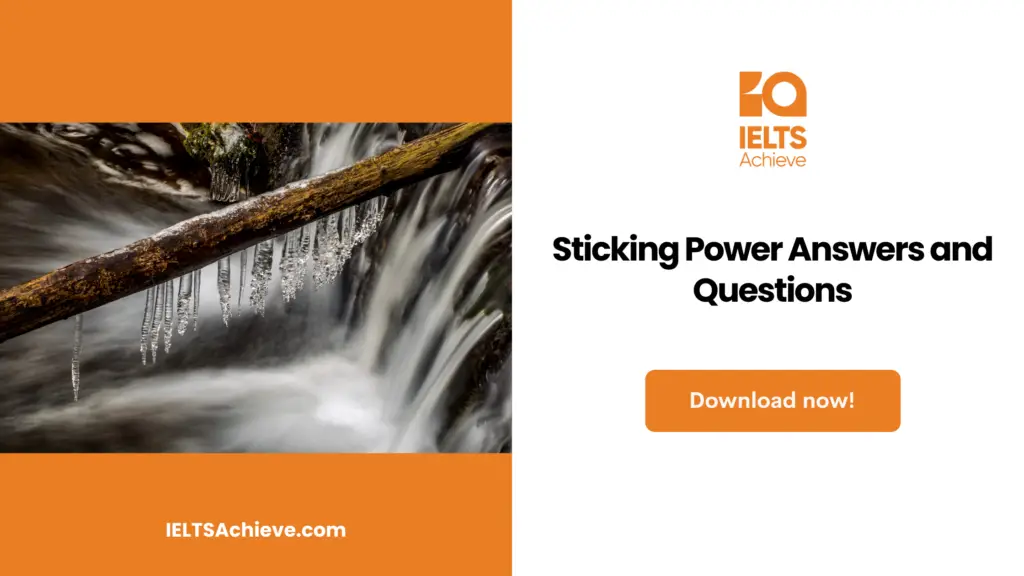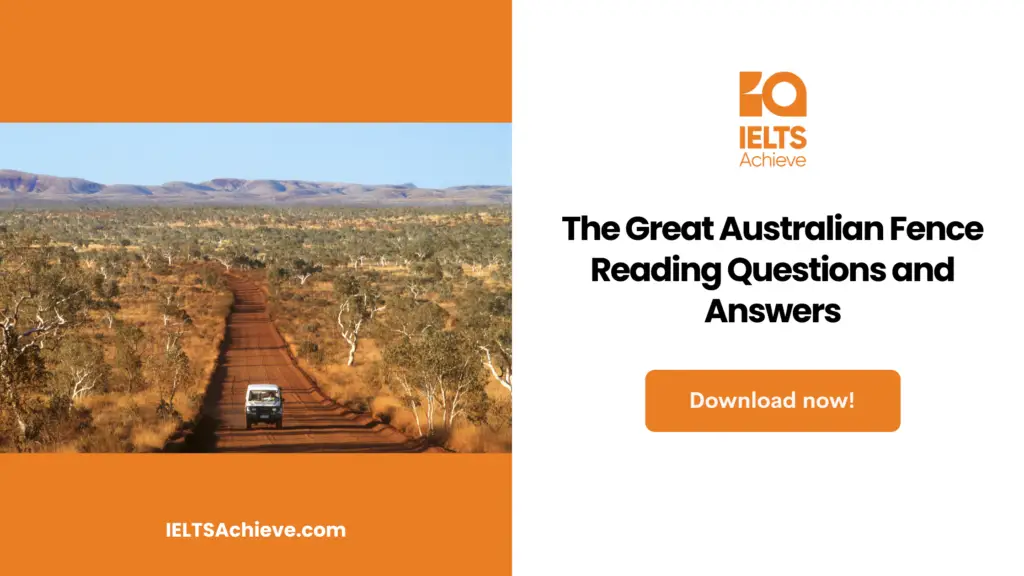The Blog post contains the following IELTS Reading Questions:
- IELTS Reading Matching Sentence Endings
- IELTS Reading Locating Information
- IELTS Reading Matching features
Stay informed and prepared for success – Explore our comprehensive Reading Test Info page to get valuable insights, exam format details, and expert tips for mastering the IELTS Reading section.
IELTS reading passage – Sticking Power

Sticking Power
A Keilar Autumn, an expert in biomechanics at Clark College in Portland, Oregon, asserts that the first footsteps on Mars are not human. They are gecko limbs. The toes of gecko possess legendary sticky properties. Scientists at Clark University want the next generation of Mars robots to have legs similar to those of geckos. A gecko can run up the smoothest walls and hang a foot from ceilings without fear of falling.
B Autumn is one of many experts that have pondered the gecko’s defying-gravity gait. This year, he and his coworkers discovered that gecko toes not only adhere to one another, but also to the surface beneath them. Engineers are already attempting to replicate gecko technology, but reptile feet are not their main focus.
C Insects are among the most tenacious “hanging” organisms. In addition to defying gravity, they can also withstand wind gusts, rainfall, and attempts by predators to pry them open. This could lead to the creation of quick-acting adhesives and minuscule graspers that are suitable for manipulating minute parts or holding small tissue fragments together during surgery. Stas Gove, a scientist in Tübingen, Germany, who is studying the issue, states, “There are many techniques to link two surfaces, but very few that allow exact and reversible bonding.
“D Both geckos and insects have perfected this method, and engineers and biologists are curious as to how. If an animal sprints on an incline, climbs vertically or moves inverted, it needs a stronger adhesive than friction. The identity of this adhesive has been the subject of heated controversy for decades. Several sources claim that they have microsuckers. Some have suggested that electrostatic forces are involved. Others believed intermolecular forces between the pad and the blade might offer a secure grip.
E The majority of data implies that insects utilise a “wet grip” by adhering to the pad with the aid of a tiny layer of moisture on its underside. Leaves a little footprint track. Some individuals have visible fluid excretion on the soles of their feet. Additionally, they frequently lose their feet while cleaning or drying their feet.
F This year, Walter Federle, an entomologist at the University of Würzburg, demonstrated experimentally that the stickiness of insects depends on a thin film of liquid beneath their feet. He placed the ants on the rotor’s polished turntable and activated the centrifuge. The ant continued travelling slowly and without hesitation. However, when the scientist gradually accelerated, the pulling force rose, the ant stopped, spread its legs, and planted all six legs firmly on the earth. Ali’s feet began to slip at increased velocity. Federle states, “This can only be explained by the presence of liquids.” “If the pull is too powerful, the ant’s paws will suddenly detach from the surface if it relies on a dry hold.”
G However, liquids are not everything. What fascinates engineers most about insect legs is the near-perfect contact they create with the surface below. Gove states that adhering to a completely flat surface is simple. However, even the smoothest surfaces in nature have minute bumps and lumps. For optimal contact, the footpads must follow the curves of the land below. Flies, beetles, and earwigs have developed bristles that bend like toothbrush bristles and pick up the dimples underneath hairy paws.
H Using this type of pad, Gorb has evaluated dozens of species to determine which ones have the best sticks. A fly can withstand forces three to four times its own weight. This is sufficient to surpass the ceiling. But bugs work better. Champions are little blue insects with elongated yellow legs that are native to the southeastern United States.
I This insect has captivated Tom Eisner, a chemical ecologist at Cornell University in New York, for years. Prior to roughly thirty years ago, he proposed that beetles should cling to surfaces to prevent being ripped off by predators, particularly ants. Earlier this year, both researchers evaluated the beetle’s adhesive strength and determined that it could endure a draw equivalent to approximately 80 times its own weight for approximately two minutes, and an astounding 200 times its own weight for an astounding duration. Rice paddies. “Ants surrender because beetles outlive them,” he explains.
J Geckos appear capable of surviving without the same necessities as liquid insects. No one is certain why geckos require so much stickiness. Autumn states, “It appears overbuilt for the job.” Regardless of the gecko’s requirements, expertise is in demand among humans. Autumn and his Oregon colleagues have previously developed a gecko-like walking robot. The Massachusetts-based iRobot created the Mecho-Gecko robot, which walks like a lizard. To stick, however, you will have to settle for a bead of glue for the time being. To develop a robot with all of the gecko’s abilities, the next stage is to reproduce the gecko’s toe hairs. Thus, it is possible to create a robot whose legs adhere without glue, clean themselves, and function just as effectively underwater as they do in the vacuum of space or when traversing the dusty terrain of Mars.
Unlock your full potential in the IELTS Reading section – Visit our IELTS Reading Practice Question Answer page now!
Recommended Questions:
Renewable Energy IELTS Reading Question with Answer
Sticking Power reading questions
Questions 14-17
Complete each sentence with the correct ending A-G below. Write the correct Letters, A-G in boxes 14-17 on your answer sheet.
| A | Stick to surfaces in and out of water |
| B | Curl up and down |
| C | Are washed and dried |
| D | Resist a pull of three times their body weight |
| E | Start to slip across the surface |
| F | Leave yellow footprints |
| G | Have hairy footpads |
14.Insect feet lose their sticking power when they
15.If you put ants on a rapidly rotating object, their feet
16.Beetles can stick to uneven surfaces because they
17.the toes on robots like Mecho-Gecko.
Ready to sharpen your skills in Matching Sentence Endings? Click here to discover expert strategies and techniques for accurately matching sentence endings with the corresponding information in the IELTS Reading section.
Questions 18-21
Reading Passage 2 has ten paragraphs A-J. Which paragraph contains the following information? Write the correct letter A-J in boxes 18-21 on your answer sheet.
18. Experts have proposed three distinct explanations for why insect feet stick.
19. A description of an experiment with a moving bug
20. Some of the practical applications for a gecko-style glue
21. notable examples of gecko movements
Questions 22-26
Look at the following statements (Questions 14-18) and the list of scientists below. Match each statement with the correct scientist A, B, C or D. Write the correct letter A, B, C or D in boxes 22-26 on your answer sheet.
List of Scientists
- Keilar Autumn
- Stas Gorb
- Walter Federte
- Tom Eisner
22. A robot with gecko-like feet might be suitable for planetary exploration.
23. What distinguishes the feet of sticky insects is their ability to effortlessly separate from surfaces.
24.Gecko feet appear to be stickier than necessary.
25.Some insects employ their ability to adhere to surfaces as a defensive mechanism.
26.Evidence indicates that insect feet must be wet in order to adhere.
Improve your performance in Matching Features questions by clicking here to access our comprehensive guide. Learn how to match specific features or characteristics with the options provided in the IELTS Reading section.
Unlock your full potential in the IELTS Reading section – Visit our IELTS Reading Practice Question Answer page now!
Recommended Questions:
Renewable Energy IELTS Reading Question with Answer
Sticking Power reading answers
14. C
15. E
16. G
17. B
18. D
19. F
20. C
21. A
22. A
23. B
24. A
25. D
26. C

We hope you found this post useful in helping you to study for the IELTS Test. If you have any questions please let us know in the comments below or on the Facebook page.
The best way to keep up to date with posts like this is to like us on Facebook, then follow us on Instagram and Pinterest. If you need help preparing for the IELTS Test, join the IELTS Achieve Academy and see how we can assist you to achieve your desired band score. We offer an essay correction service, mock exams and online courses.

